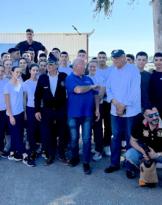Today at the 18: 00 at the Turin Book Fair, 3 Pavilion, "Arena Piemonte" (500 seats) the book "Carabinieri Aviatori a Torino" (book downloadable for free from the site will be presented) www.museoagusta.it): an opportunity to retrace the history, current events and prospects of helicopter rescue in Piedmont.
Few perhaps know that this form of aerial emergency assistance has in Piedmontese helicopter rescue an absolute pole of excellence that owes much to the organizational inheritance gathered by the 1 ° carabinieri helicopter core di Volpiano (TO) that last year celebrated the 50 years of activity and that had among its commanders the author of the book, magg. of the reserve of the Carabinieri Francesco Golini, Bronze Medal for Military Value (and we would like to underline that this is not the most usual decoration for civil or aeronautical value).
The beginning of the history of these aviation activities is very distant and leads us to the beginnings of aviation, when a particular department of the Royal Army was established in Turin: the aviators battalion.
As we can well understand from the name of this flight department, the first aims were mainly military, with companies in the first absolute war in the way with use of air component (Italo-Turkish conflict of 1911-'12) then in Cyrenaica. Delivered to the Air Force (born in 1923) the task of air defense of the country, the operational legacy of that aviators battalion who saw 174 carabinieri clowning on bombing biplanes and hunting monoplanes, remained at the 1 ° nucleus helicopters of the carabinieri.
A flight department with tasks that are very different from those of their precursors and that for the purpose of air rescue (obviously to the carabinieri if they require even very different ones, fundamentally linked to tasks of military police of emergency) has also undergone a considerable internal evolution consequent to the evolution itself of the helicopter and its instrumentation.
Of these themes, for the most part treated in his book, the major. Golini will also give more details during today's conference and it will be above all the information he will give about the establishment and development of civil helicopter rescue to make participation particularly interesting.
We therefore leave you to the reading of the book which explains every detail resulting in a meticulous and detailed historical research, without ever becoming "heavy".












